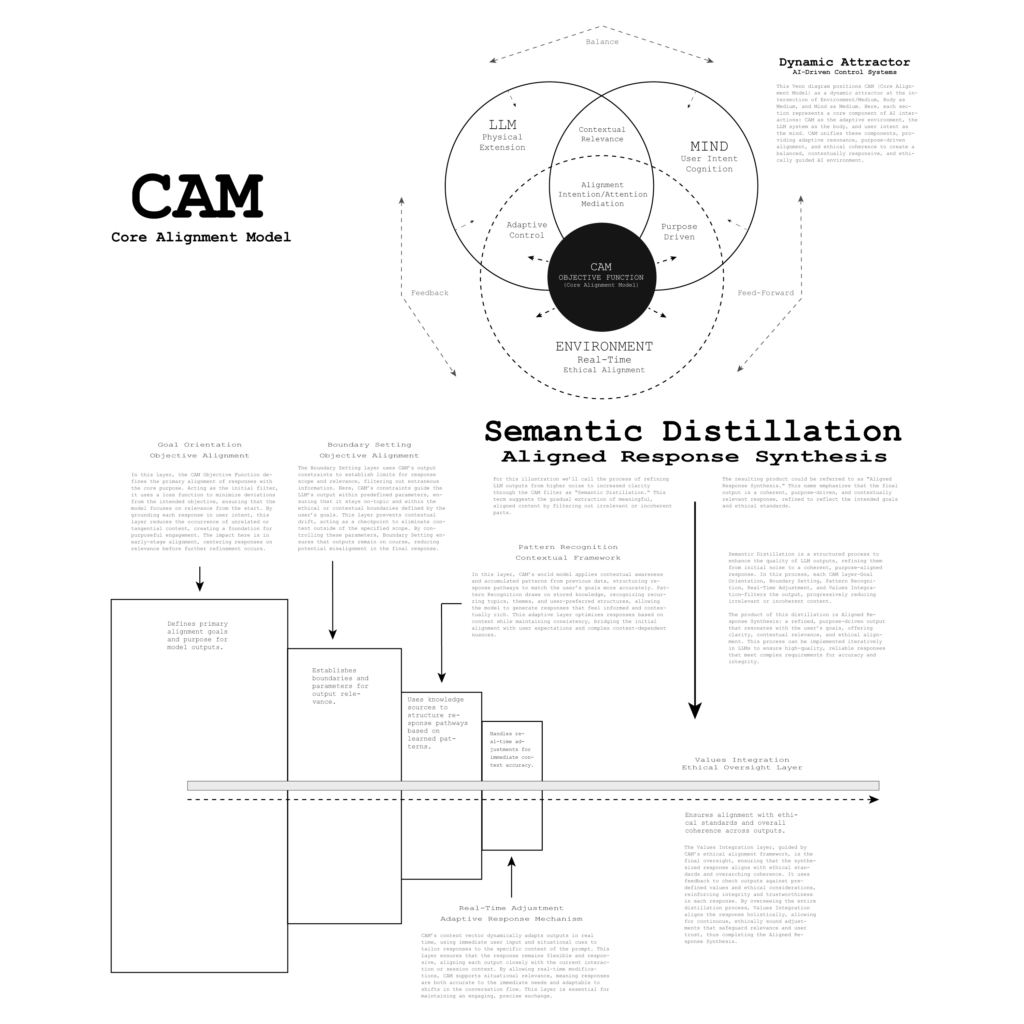As the Semantic Distillation process moves through each layer, CAM progressively channels raw LLM output from a broad, often noisy initial state toward a refined, high-integrity response. Each layer’s unique role allows it to act as a filter that captures and discards unnecessary or contextually inappropriate elements, allowing only the most purpose-aligned information to pass through.
- CAM as an Attractor: CAM acts as an attractor in the AI-human-environment triad. This means it constantly draws the LLM’s outputs toward a central point of alignment with human intent and real-time environmental context. Instead of the model generating a static response, CAM’s dynamic filtering pulls the response into coherence with the immediate context, which adapts based on live user input and real-world situational factors.
- Progressive Filtering for Clarity: Each CAM layer builds upon the output from the previous layer, progressively reducing ambiguity and sharpening relevance. Goal Orientation focuses on intent alignment, removing off-topic or misaligned content; Boundary Setting then limits the response scope, reinforcing coherence within specified limits. Each layer’s filtration contributes to a progressively more refined state that clarifies output meaning.
- Adaptive, Real-Time Integration: The Real-Time Adjustment layer allows CAM to operate as a living system within the LLM, enabling it to respond in real time to shifts in user interaction or context. This adaptability is essential for generating responses that don’t just meet predefined goals but are situationally aware and responsive to evolving conversational flow.
- Ethical Consistency and Integrity: Values Integration ensures ethical coherence by applying checks that align the final response with the broader ethical guidelines of the application context. In AI deployments where ethical considerations are critical, this layer is crucial for producing outputs that are not only relevant but responsible and user-aligned.
Enabled Features and Advantages
- Enhanced Coherence and Reliability: By continuously filtering through layers, CAM eliminates common issues like context drift and hallucinations, enabling LLMs to produce responses with higher reliability and alignment.
- Ethical Assurance: The Values Integration layer acts as a safeguard against unethical outputs, providing a structured way to ensure that each response aligns with core ethical standards, which is vital for applications in sensitive fields like healthcare or education.
- Contextual Precision: The CAM process creates context-sensitive responses by using adaptive context vectors that help LLMs stay anchored to the immediate conversational focus, enhancing their practical utility.

Imagine CAM as a funnel with distinct filtration layers where input starts broad and noisy, containing all possible responses, and then progressively narrows, retaining only the elements that align with the user’s goals, ethics, and context. As each filter layer removes more noise, the output at the end of the funnel is a distilled, precise response—a product of Aligned Response Synthesis. This visual model helps illustrate how CAM continuously interacts with and refines LLM output, ensuring the end product is purpose-driven, contextually appropriate, and ethically aligned.
By visualizing CAM as a live, interactive funnel that constantly fine-tunes LLM responses, users can better understand how Semantic Distillation provides adaptive, real-time clarity in complex and dynamic conversational environments.
